Toyota RAV4 (XA40) 2013-2018 Service Manual: Pressure sensor circuit
![]()
Description
This dtc is output when the refrigerant pressure is either extremely low (0.19 Mpa [2.0 Kgf/cm2, 28 psi] or less) or extremely high (3.14 Mpa [32.0 Kgf/cm2, 455 psi] or more). The air conditioning pressure sensor, which is installed on the pipe of the high pressure side, detects the refrigerant pressure and sends refrigerant pressure signals to the air conditioning amplifier. The air conditioning amplifier determines the pressure from the signals in accordance with the sensor characteristics, and controls the compressor accordingly.

Wiring diagram
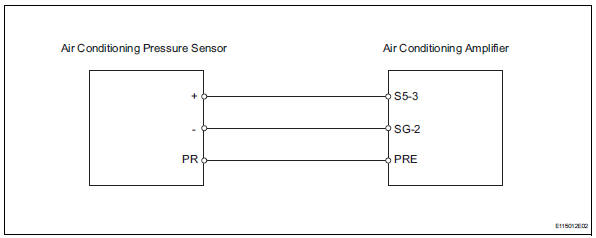
Inspection procedure
- Check refrigerant
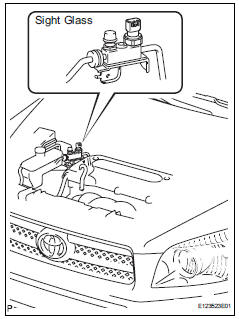
- Check the sight glass of the cooler unit refrigerant liquid pipe.
- Prepare the vehicle in accordance with the chart
below.

- Compare the sight glass to the following chart.
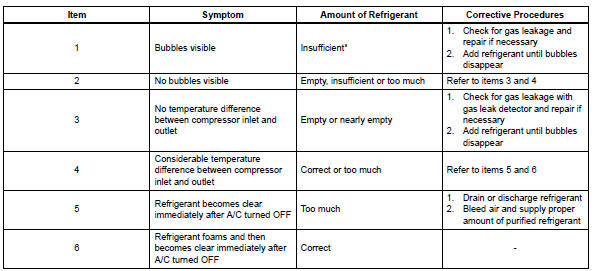
Hint:
*: If the ambient temperature is higher than usual but cooling is sufficient, bubbles in the sight glass are permissible.


- Read value of intelligent tester (reg press sens)
- Connect the intelligent tester (with can vim) to the dlc3.
- Turn the ignition switch on and turn the intelligent tester main switch on.
- Select the item below in the data list, and read the value displayed on the intelligent tester.

Ok: the display is as specified in the normal condition column.



- Check wire harness (pressure sensor - air conditioning amplifier)
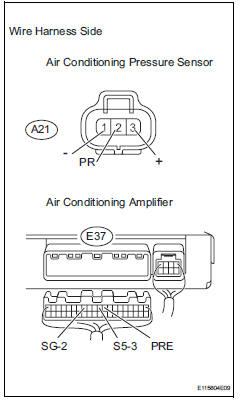
- Disconnect the a21 pressure sensor connector.
- Disconnect the e37 amplifier connector.
- Measure the resistance of the wire harness side connectors.
Standard resistance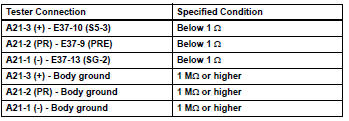


- Check air conditioning amplifier
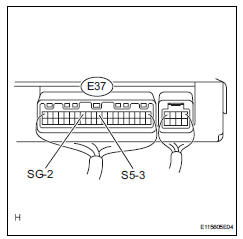
- Remove the air conditioning amplifier with its connectors still connected.
- Measure the resistance of the wire harness side connector.
Standard resistance 
- Turn the ignition switch on.
- Measure the voltage of the wire harness side connector.
Standard voltage 


- Inspect air conditioning pressure sensor
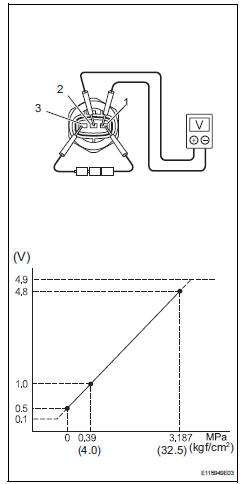
- Turn the a/c switch on.
- Disconnect the a21 sensor connector.
- Connect the three 1.5 V dry cell batteries' positive (+)
lead to terminal 3 and the negative (-) lead to terminal 1.
Then connect the voltmeter's positive (+) lead to terminal 2 and the negative (-) lead to terminal 1. Measure the voltage.
Ok: the voltage changes in accordance with the refrigerant pressure as shown in the graph.


Replace air conditioning amplifier
 Compressor lock sensor circuit
Compressor lock sensor circuit
Description
This sensor sends 1 pulse per engine revolution to the air conditioning
amplifier. If the ratio of the
compressor speed divided by the engine speed is smaller than a predetermined ...
 Solar sensor circuit (driver side)
Solar sensor circuit (driver side)
Description
The solar sensor, which is installed on the upper side of the instrument
panel, detects sunlight and
controls the air conditioning auto mode. The output voltage from the solar
se ...
Other materials:
System description
Power door lock system description
The power door lock system locks / unlocks all
doors with a one-touch operation.
The door control switch of the power window
regulator master switch or door control switch on
passenger side sends lock / unlock request
signals to the main body ...
High beam automatic turning on or off conditions
When all of the following conditions are fulfilled, high beam will be
automatically turned on:
Vehicle speed is above approximately 21 mph (34 km/h).
The area ahead of the vehicle is dark.
There are no oncoming or preceding vehicles with headlights or tail
lights turned on.
There are fe ...
Components
...
